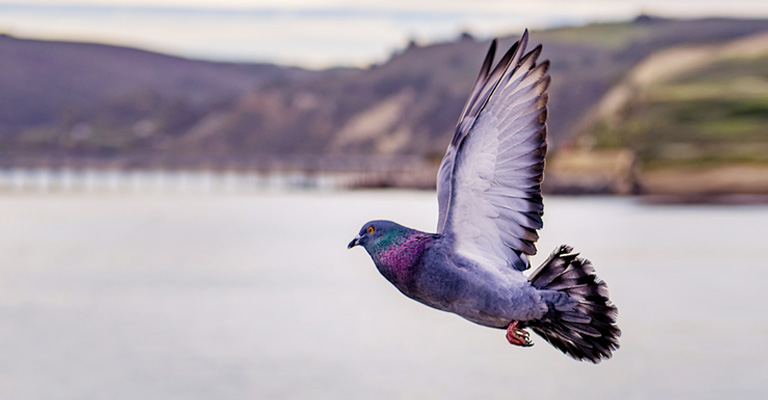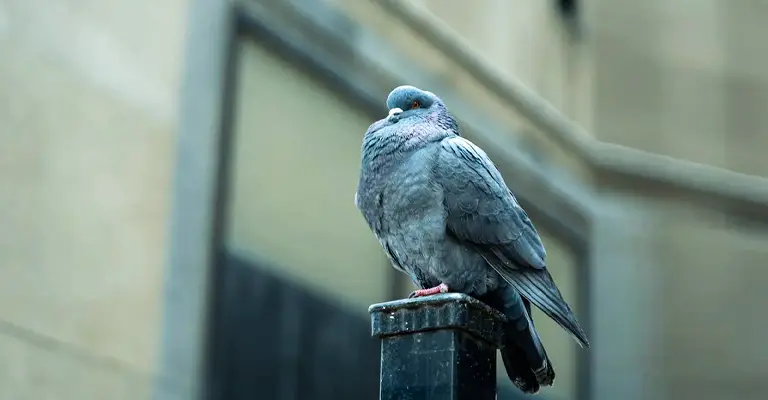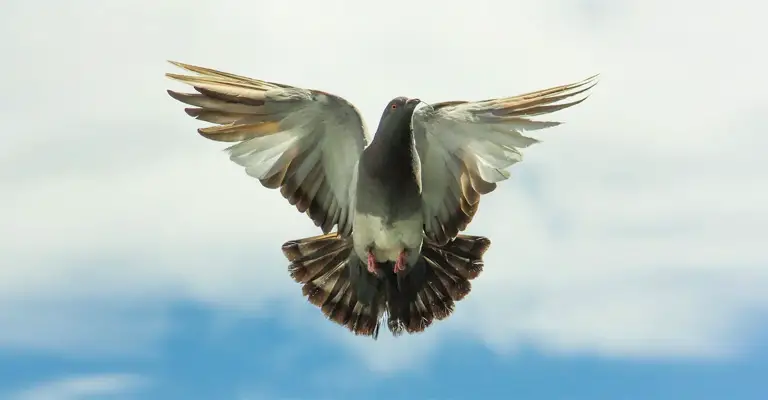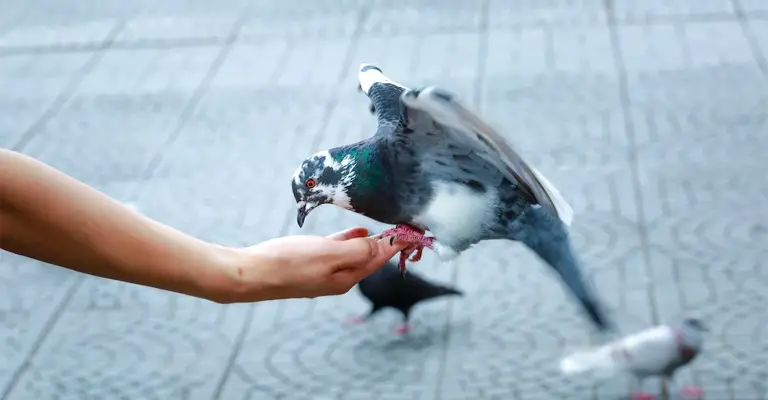Pigeons, also known as rock doves, are a common sight in urban areas. These birds are known for their ability to fly, which allows them to navigate through the city and find food and shelter.
However, there may be instances where a pigeon may not be able to fly away, either due to an injury or illness.
In this blog post, we will explore the reasons why a pigeon might not be able to fly, the factors that can contribute to this condition, and what you can do to help an injured or non-flying pigeon.
We will also discuss the importance of protecting and conserving these birds, as they play a crucial role in the balance of nature.

Reasons Why a Pigeon Might Not Be Able to Fly
Reasons, why a pigeon might not be able to fly, can vary, but some of the most common causes include physical injuries, illnesses, and poor health. Here are the possible reasons that might bother your beautiful pigeons.
Physical Injuries
Pigeons are prone to injuries, just like any other animal. A common injury that can prevent a pigeon from flying is a broken or sprained wing.
These injuries can occur due to collisions with buildings or vehicles, or from being caught in a trap or caught by a predator.
A broken or sprained wing can be very painful and can take a long time to heal. In some cases, the wing may never fully heal, preventing the pigeon from being able to fly again.
Illnesses

Pigeons can also develop illnesses that affect their ability to fly. Avian influenza, also known as bird flu, is a viral infection that can cause respiratory problems and muscle weakness in pigeons. Bird malaria, a disease caused by a parasite, can also affect a pigeon’s ability to fly.
These illnesses can also make the pigeon weaker and more susceptible to other diseases, which can further impact its ability to fly.
Poor Health
Pigeons that are malnourished or have a poor diet may not have the strength or energy to fly. This can happen due to a lack of food and clean water in their environment, or due to human interference such as feeding them inappropriate foods. Additionally, if a pigeon is too young or old, it may not have the physical capability to fly.
These are some of the most common reasons why a pigeon might not be able to fly, but there can be other causes as well. It’s important to remember that every case is unique and requires proper examination and diagnosis by an expert.
External Factors That Can Contribute to a Pigeon’s Inability to Fly

As the reasons vary, there are various external factors that can contribute to a pigeon’s inability to fly, some of which are related to human activity, predators, and human interference.
Impact of Human Activity
Pigeons are often found in urban areas, where they can be affected by human activities such as pollution and habitat destruction.
Pollution can have a negative impact on a pigeon’s health, making it more susceptible to illnesses and injuries.
Habitat destruction can also limit the availability of food and shelter for pigeons, which can lead to malnourishment and poor health, making it harder for the pigeon to fly.
Predators
Pigeons are preyed upon by a variety of animals, including cats and foxes. These predators can cause injuries to pigeons that can prevent them from flying.
Furthermore, the presence of predators can also cause stress and fear to the pigeon, which can affect its ability to fly.
Human Interference

Human interference can also impact a pigeon’s ability to fly. One example is feeding them inappropriate food, which can lead to malnourishment and poor health.
Furthermore, if a pigeon is kept in captivity, it may not have the opportunity to fly and develop the strength and stamina needed to fly in the wild.
Additionally, people might try to capture or trap pigeons, this can cause injuries or stress that prevent the pigeon from flying.
It’s important to note that these factors can have a cumulative effect on a pigeon’s ability to fly. For example, a pigeon that is already malnourished due to a lack of food may be more susceptible to injuries from predators or pollution.
Therefore, it’s crucial to take a comprehensive approach to understand and address the factors that contribute to a pigeon’s inability to fly.
How to Help an Injured or Non-flying Pigeon
If you come across an injured or non-flying pigeon, there are steps you can take to help ensure the bird’s well-being and chances of recovery.
Provide Food, Water, and Shelter
One of the most important things you can do is to provide the pigeon with food, water, and shelter. Offer the pigeon a bowl of clean water, as well as a source of food, such as birdseed or fruit. Provide a safe and warm place for the pigeon to rest, such as a cardboard box or pet carrier.
Keep the Pigeon Safe From Predators
Pigeons are prey for many animals, so it’s important to keep the pigeon safe from predators, such as cats and foxes. If you’re keeping the pigeon in your garden, make sure to secure the area so that predators can’t get in.
Contact a Bird Sanctuary or Veterinarian
If the pigeon is severely injured or has a disease, it may need professional care. Contact a local bird sanctuary or veterinarian who specializes in birds to get advice on how to best care for the pigeon. They can also provide medical treatment or rehabilitation if needed.
Contact RSPCA or Rspb
If you are unable to find a bird sanctuary or veterinarian nearby, you can contact the RSPCA or RSPB for advice on how to care for the pigeon.
They can also provide you with information on the nearest rescue center or wildlife rehab center. Keep in mind that they may not be able to come out to collect the pigeon.
Release the Pigeon
Once the pigeon has recovered, it is important to release it back into the wild. Make sure the release location is safe and has an adequate food and water source.
It’s important to note that it is illegal to keep wild birds as pets in many countries. Care for the pigeon should only be temporary until it is possible to release it or to find a sanctuary or veterinarian that can take care of it.
It’s also important to remember that wild animals can carry diseases that can be transmitted to humans or other animals, so always handle them with care and wear gloves if necessary.
FAQs
If you find a non-flying pigeon, you should provide it with food, water, and shelter. Offer the pigeon a bowl of clean water and a source of food, such as birdseed or fruit. Provide a safe and warm place for the pigeon to rest, such as a cardboard box or pet carrier. Keep the pigeon safe from predators and contact a local bird sanctuary or veterinarian for advice on how to best care for the pigeon.
It can be difficult to tell if a pigeon is injured or just weak. Injuries such as broken or sprained wings may be visible, but other injuries may not be as obvious. If the pigeon is unable to fly or is having difficulty flying, it may be injured or weak. It’s best to contact a local bird sanctuary or veterinarian for advice on how to best care for the pigeon.
It’s important to release a pigeon back into the wild once it has recovered, however, if the pigeon’s injury or illness is severe, it may not be able to survive in the wild. In this case, it may be necessary to provide permanent care for the pigeon. Contact a local bird sanctuary or veterinarian for advice on how to best care for the pigeon.
It is illegal to keep wild birds as pets in many countries, and it is not recommended to keep a pigeon as a pet. Pigeons belong in the wild, and keeping them in captivity can be harmful to their health and well-being. If you come across an injured or non-flying pigeon, it is important to provide temporary care until it can be released or cared for by a professional.
There are some risks associated with caring for a non-flying pigeon, such as the risk of contracting a disease from the bird. It’s important to handle the pigeon with care and wear gloves if necessary. Additionally, it’s important to release the pigeon back into the wild once it has recovered, as keeping a wild bird in captivity can be harmful to its health and well-being.
Wrapping Up
As you’ve learned, pigeons not being able to fly away can be caused by a variety of factors, including physical injuries, illnesses, poor health, and human activity.
It is important to understand that every case is unique and requires proper examination and diagnosis by an expert.
As responsible citizens, it is our duty to help non-flying pigeons in need by providing food, water, and shelter, keeping them safe from predators, and contacting local bird sanctuaries or veterinarians for assistance.
Additionally, we can contact organizations like the RSPCA or RSPB for advice. Once the pigeon has recovered, it should be released back into the wild.
Please be kind to those poor birds and help them survive. Best of luck and lots of good wishes.